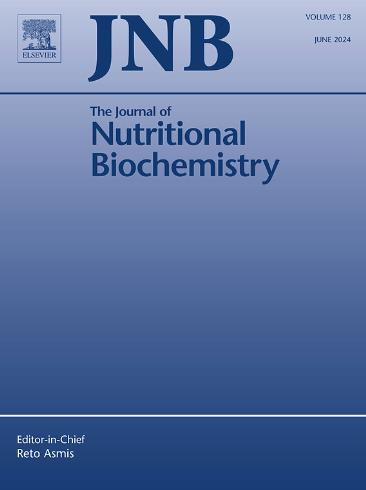富含n-3多不饱和脂肪酸的鱼油通过涉及Retsat上调的机制减轻慢性酒精诱导的肝损伤。
IF 4.8
2区 医学
Q1 BIOCHEMISTRY & MOLECULAR BIOLOGY
引用次数: 0
摘要
本研究旨在阐明鱼油对酒精性肝病(ALD)的保护作用,确定二十碳五烯酸(EPA, C20:5 n-3)和二十二碳六烯酸(DHA, C22:6 n-3)之间的主要活性成分,并阐明其分子机制。将C57BL/6J小鼠随机分为酒精喂养(AF)和配对喂养(PF)两组,分别添加鱼油(FO)或玉米油(CO),喂养4周。此外,我们还利用AML-12细胞进行了一系列体外实验,进一步探讨其潜在机制。结果表明,与AF-CO组相比,AF-FO组血浆丙氨酸转氨酶(ALT)和天冬氨酸转氨酶(AST)水平显著降低,表明鱼油可减轻酒精性肝损伤。肝抗氧化标志物,包括谷胱甘肽(GSH)、超氧化物歧化酶(SOD)和过氧化氢酶(CAT), AF-FO组也高于AF-CO组。转录组学分析显示,鱼油添加显著影响了氧化还原酶活性和脂质代谢途径相关基因,其中Retsat是上调幅度最大的基因。体外实验表明,与亚油酸(LA, C18:2 n-6)相比,DHA显著提高了Retsat表达、细胞活力以及氧化还原酶活性和脂质代谢相关基因的表达,而EPA没有显著提高(LA, C18:2 n-6)。值得注意的是,敲除Retsat会消除DHA的保护作用。综上所述,膳食鱼油主要通过DHA上调Retsat和与氧化还原酶功能和脂质代谢相关的下游基因来减轻慢性酒精性肝损伤。本文章由计算机程序翻译,如有差异,请以英文原文为准。
n-3 polyunsaturated fatty acids-enriched fish oil attenuates chronic alcohol-induced liver injury via a mechanism involving the upregulation of Retsat
This study aimed to delineate the protective role of fish oil against alcoholic liver disease (ALD), identify the principal active component between eicosapentaenoic acid (EPA, C20:5 n-3) and docosahexaenoic acid (DHA, C22:6 n-3), and elucidate the molecular mechanisms. C57BL/6J mice were randomly assigned to receive either an alcohol-fed (AF) or pair-fed control (PF) diet, enriched with fish oil (FO) or corn oil (CO) for four weeks. Additionally, a series of in vitro experiments were performed using AML-12 cells to further investigate potential mechanisms. The results showed that plasma levels of alanine aminotransferase (ALT) and aspartate aminotransferase (AST) were significantly lower in the AF-FO group compared to the AF-CO group, indicating that fish oil alleviated alcohol-induced liver damage. Hepatic antioxidant markers, including glutathione (GSH), superoxide dismutase (SOD), and catalase (CAT) were also higher in the AF-FO group than in the AF-CO group. Transcriptomic analysis revealed FO supplementation significantly affected genes involved in oxidoreductase activity and lipid metabolism pathways, with Retsat being the most up-regulated gene. The in vitro experiments indicated that DHA, but not EPA, markedly increased Retsat expression, cell viability, and the expression of genes related to oxidoreductase activity and lipid metabolism, compared to linoleic acid (LA, C18:2 n-6). Notably, knocking down Retsat abolished the protective effects of DHA. In conclusion, dietary fish oil mitigated chronic alcohol-induced liver injury primarily through DHA by upregulating Retsat and downstream genes associated with oxidoreductase function and lipid metabolism.
求助全文
通过发布文献求助,成功后即可免费获取论文全文。
去求助
来源期刊

Journal of Nutritional Biochemistry
医学-生化与分子生物学
CiteScore
9.50
自引率
3.60%
发文量
237
审稿时长
68 days
期刊介绍:
Devoted to advancements in nutritional sciences, The Journal of Nutritional Biochemistry presents experimental nutrition research as it relates to: biochemistry, molecular biology, toxicology, or physiology.
Rigorous reviews by an international editorial board of distinguished scientists ensure publication of the most current and key research being conducted in nutrition at the cellular, animal and human level. In addition to its monthly features of critical reviews and research articles, The Journal of Nutritional Biochemistry also periodically publishes emerging issues, experimental methods, and other types of articles.
 求助内容:
求助内容: 应助结果提醒方式:
应助结果提醒方式:


